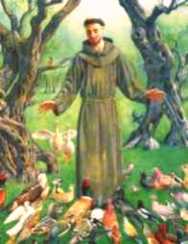 Por Leonardo Boff
Por Leonardo Boff
Que un Papa lleve el nombre de Francisco no puede ser en vano. Además de ser una referencia a otro modo de ser Iglesia, más cercana a la gruta de Belén que a los palacios de Jerusalén, Francisco de Asís plantea un asunto de extrema urgencia hoy en día: la cuestión de la protección de la vitalidad del planeta Tierra y la garantía del futuro de nuestra civilización. Para este propósito la ecología exterior sola es insuficiente. Tenemos que amalgamarla con la ecología interior. Eso fue lo que hizo de forma paradigmática san Francisco de Asís.
Ecología exterior es esa sintonía con los ritmos de la naturaleza y con el proceso cósmico que se realiza en la dialéctica de orden-desorden-interacción-nuevo orden. Esta ecología asegura la perpetuidad del proceso evolutivo que incluye la tierra y la biodiversidad. Pero a nivel humano sólo se produce si hay una contrapartida de nuestro lado, que se deriva de nuestra ecología interior. Por ella, el universo y sus seres están dentro de nosotros en forma de símbolos que hablan de arquetipos que nos guían y de imágenes que habitan nuestra interioridad: materiales con los que continuamente debemos dialogar e integrar. Si hay violencia en la ecología exterior es señal de que existe turbulencia en nuestra ecología interior y viceversa. No sabemos armonizar las ecologías descritas por F. Guattari y por mí: la ambiental, la social, la mental y la integral.
En su Cántico al Hermano Sol san Francisco revela la convivencia de estas dos ecologías. Su extraordinario logro espiritual fue reconciliar el mundo con Dios, el cielo con la Tierra y la vida con la muerte. Para entender toda esta experiencia espiritual es necesario leer el texto más allá de su letra y bajar al nivel simbólico donde los elementos cantados vienen impregnados de emoción y de significado. El contexto existencial es significativo: Francisco está muy enfermo y casi ciego, cuidado por santa Clara en la capilla de San Damián donde ella vivía con sus hermanas. De repente, en plena noche, tiene una especie de exaltación del espíritu, como si estuviese ya en el Reino de los cielos. Radiante de alegría, se levanta, compone un himno a todas las criaturas, y lo canta con sus cofrades. Celebra los grandes esponsales del "señor hermano Sol" y la "señora hermana Tierra". De estos esponsales nacen todos los seres, dispuestos en pares, masculino y femenino, que según C.G. Jung constituyen el arquetipo más universal de la totalidad psíquica: sol-luna, viento-agua, fuego-tierra, totalidad alcanzada en su andadura espiritual.
El himno contiene dos estrofas más, añadidas por el Poverello. En ellas ya no se canta al cosmos material, sino al cosmos humano que también busca reconciliación: entre el obispo y el alcalde de Asís. Finalmente se reconcilia con la hermana muerte, el complejo más difícil de ser integrado por el aparato psíquico humano. El ser humano se reconcilia con otro ser humano. La vida abraza a la muerte como hermana, portadora de la eternidad.
La ecología interior integrada con la ecología exterior alcanza en Francisco un intérprete privilegiado. Él es como una finísima cuerda del universo en la cual la más sutil nota musical resuena y se have oír.
Nuestra cultura es deudora del padre de san Francisco, Pedro Bernardone, rico comerciante en telas, en busca de riqueza y esplendor. Confiesa el gran historiador inglés Arnold Toynbee: «Francisco, el mayor de los hombres de Occidente, debe ser imitado por todos nosotros, pues su actitud es la única que puede salvar a la Tierra» (Diario ABC, Madrid, 19/12/1972,10).
¿Cuál es nuestro desiderátum? Que Francisco de Roma bajo la inspiración de Francisco de Asís se convierta, por su humildad, pobreza y jovialidad, en un amante de la Madre Tierra y en un defensor de todo tipo de vida, especialmente de la vida más amenazada, que es la de los pobres. Y que suscite esa conciencia en la humanidad. En él están presentes todos los carismas que lo pueden hacer un faro de referencia ecológica y humanitaria para todo el mundo.
26.04.2013
Francis of Rome and the Ecology of Saint Francis of Assisi
Leonardo Boff
It cannot be for nothing that a Pope takes the name of Francis. Besides being a reference to another model of being Church, closer to the manger of Bethlehem than to the palaces of Jerusalem, Francis of Assisi posits a theme that is of extreme urgency now: the question of protecting the vitality of planet Earth and guaranteeing the future of our civilization. Exterior ecology alone is insufficient for this purpose. We must amalgamate it with interior ecology. That is what Saint Francis of Assisi did in a pragmatic way.
Exterior ecology is that syntony between the rhythms of nature and the cosmic process that is realized in the dialectic of order-disorder-interaction-new order. This ecology assures the perpetuity of the process of evolution that includes the Earth and her biodiversity. But at the human level, it only occurs if there is a counter-weight from our side, one which derives from our interior ecology. Through that interior ecology, the universe and all its beings are within us, in the form of symbols that speak of the archetypes that guide us and of the images that inhabit our inwardness, and with which we must constantly dialogue and integrate. External violence is a sign of turbulence in our interior ecology, and vice versa. We do not know how to harmonize the ecologies described by Pierre-Felix Guattari and by myself: the environmental, social, mental and integral ecology.
In his Song of Brother Sun, Saint Francis reveals the fellowship of these two ecologies. His extraordinary spiritual accomplishment was to reconcile the world with God, heaven with Earth, and life with death. To understand this spiritual experience we must read the text at a level beyond its words, and delve down to the symbolic level, where the song of the elements is pregnant with emotion and meaning. The existential context is meaningful: Francis was very ill and almost blind, cared for by Saint Clare of Assisi in the chapel of San Damiano where she lived with her sisters. Suddenly, in the middle of the night, he had a sort of exaltation of the spirit, as if he were already in the Kingdom of heavens. Radiant with happiness, he stands up, composes a hymn to all creatures and sings it with his brothers and sisters. He celebrates the great nuptials of the "Lord Brother Sun" and the "Woman Sister Earth". Of this union are born all beings, arranged in pairs, masculine and feminine, that according C.G. Jung, constitute the most universal archetype of the psychic totality: sun-moon, wind-water, fire-earth; a totality he reached in his spiritual journey.
The hymn contains two more stanzas, added by the Poverello. They no longer sing of the material cosmos, but the human cosmos that also seeks reconciliation: between the bishop and the major of Assisi. Finally he reconciles with sister death, the most difficult complexity to be integrated into human psychic framework. The human being reconciles himself with another human being. Life embraces death as a sister, the carrier of eternity.
The interior ecology integrated with the exterior ecology, find a privileged interpreter in Francis. Francis of Assisi is like a fine chord of the universe in which the most subtle musical note resounds and can be heard.
Our culture is indebted to the father of Saint Francis, Pedro Bernardone, a rich fabric merchant in search of wealth and splendor. As the great British historian Arnold Toynbee confesses: «Francis, the greatest man of the West, must be imitated by all of us, because his attitude is the only one that can save the Earth» (Diario ABC, Madrid, 19/12/1972,10).
What is our ideal? The one inspired by Francis of Assisi. That Francis of Rome is converted, by his humility, poverty and joviality, into a lover of Mother Earth and defender of all forms of life, especially of the most threatened, the life of the poor. And that he inspires that consciousness in humanity. Francis of Rome has all the charisma needed for him to become a beacon of ecological and humanitarian reference for all the world.
*Theologian-Philosopher
Earthcharter Commission
26.04.2013

